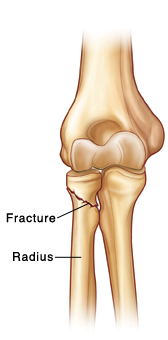Elbow Fracture

You have a break, or fracture, of the elbow. That means you have a crack or break in 1 or more of the bones of the elbow joint. Fractures often take 4 to 12 weeks to heal, depending on the type. Initial treatment is with a splint or cast. Severe fractures may need surgery to put the bone fragments back into place.
The elbow joint is formed by 3 arm bones:
-
Radius. This is the bone on the thumb side of the forearm.
-
Ulna. This is the bone on the little-finger side of the forearm. The ulna forms the tip of the elbow.
-
Humerus. This is the upper arm bone that connects to the shoulder.
Home care
-
Keep your arm raised to reduce pain and swelling. When sitting or lying down, raise your arm above heart level. You can do this by placing your arm on a pillow that rests on your chest or on a pillow at your side. This is most important during the first 48 hours after injury.
-
Apply an ice pack over the injured area for 15 to 20 minutes every 3 to 6 hours. You should do this for the first 24 to 48 hours. To make an ice pack, put ice cubes in a plastic bag that seals at the top. Wrap the bag in a clean, thin towel or cloth. Never put ice or an ice pack directly on your skin. You can place the ice pack inside the sling and directly over the splint. Keep using ice packs to ease pain and swelling as needed. As the ice melts, be careful to not get your wrap, splint, or cast wet. After 48 hours, apply heat (warm shower or warm bath) for 15 to 20 minutes several times a day. Or switch between ice and heat.
-
If you were given a sling and splint, leave it in place for the time advised. Keep the splint completely dry at all times. Bathe with your splint out of the water protected with 2 large plastic bags, one outside of the other, each sealed with duct tape or rubber bands at the top end. If a fiberglass splint or cast gets wet, you can dry it with a hair dryer on a cool setting.
-
If you were given only a sling, wear it for the first week. Unless told otherwise, slowly begin range of motion exercises, after the first week, or as advised by your healthcare provider.
-
You may use over-the-counter pain medicine to control pain, unless another pain medicine was prescribed. If you have chronic liver or kidney disease or ever had a stomach ulcer or GI (gastrointestinal) bleeding, talk with your healthcare provider about using these medicines.
Follow-up care
Follow up with your healthcare provider as advised.
An elbow joint will become stiff if kept still (immobile) for too long. Ask your healthcare provider when to begin range of motion exercises to prevent the elbow from getting stiff. If X-rays were taken, you will be told if there are any new findings that may affect your care.
When to get medical advice
Call your healthcare provider right away if any of these occur:
-
The plaster splint or cast becomes wet or soft.
-
The splint or cast becomes loose.
-
The fiberglass splint or cast remains wet for more than 24 hours.
-
Increased tightness or pain develops in the elbow.
-
The cast or splint has a bad smell.
-
Your fingers become swollen, cold, blue, numb, or tingly.
Online Medical Reviewer:
L Renee Watson MSN RN
Online Medical Reviewer:
Raymond Turley Jr PA-C
Online Medical Reviewer:
Thomas N Joseph MD
Date Last Reviewed:
1/1/2022
© 2000-2024 The StayWell Company, LLC. All rights reserved. This information is not intended as a substitute for professional medical care. Always follow your healthcare professional's instructions.